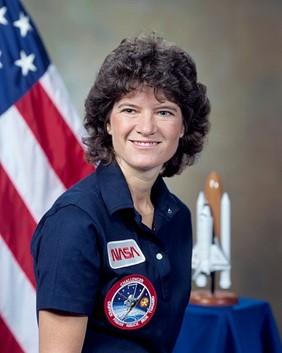Year born: 1951
Research Areas: Spaceflight, Physics, X-rays
"All adventures, especially into new territory, are scary. "
Source: Sally Ride, Susan Okie (1986). “To Space & Back”

Early Life
Sally grew up in Los Angeles, California. As a child, Sally loved science and her parents encouraged her by giving her a chemistry set and a telescope. Sally studied English and physics at Stanford University. She stayed at Stanford to study for a master’s degree and a PhD. Sally's research was on how x-rays behaved in the interstellar medium. The interstellar medium is the stuff between the stars.
At Stanford, Sally saw a job advert in a newspaper. NASA were looking for scientists and engineers to be astronauts. Sally applied and in 1978 NASA accepted her onto their training programme. This was the first time NASA had allowed women to become astronauts. Over 8000 people applied and Sally was one of 35 trainees chosen.
Career Highlights
Sally completed her NASA training in 1979. At first she worked as a spacecraft communicator, also known as ‘CAPCOM’. CAPCOM is the person in mission control who talks to the astronauts in space. Sally was the first female CAPCOM. Sally also helped to develop a robot arm for NASA’s Space Shuttle programme.
In 1983, Sally became the first American woman to travel to space. At the age of 32, she was also the youngest American astronaut. Sally travelled on the Space Shuttle Challenger. Her job on the mission was to operate the robotic arm and launch satellites. In 1984, Sally travelled on the Challenger again. This was the first ever NASA flight to have two female astronauts on board. In total, Sally spent more than 343 hours in space.
In 1986, Sally was preparing to fly to space again when the Space Shuttle Challenger broke apart shortly after take-off. The disaster killed all 7 crew members on board. Sally was part of the team that looked into the cause of the disaster. She also authored an influential report on NASA’s future called ‘The Ride Report.
Sally left NASA in 1987. She worked at Stanford University and taught at University of California, San Diego. Sally was also director of the University of California’s, California Space Institute.
Sally, her partner Tam, and 3 colleagues, founded Sally Ride Science. Sally Ride Science aims to make sure girls and boys from all backgrounds see people in science who look like them. Sally also contributed to seven children’s books based on space.
Legacy
Sally has received many honours from NASA and various universities. A year after her death, US President Obama awarded Sally the USA’s highest civilian honour. Sally’s partner, Tam accepted The Presidential Medal of Freedom on her behalf.
Sally was a private person. Sally and Tam's 27-year relationship was only first made public in Sally's obituary. This added to Sally's legacy, making her first known LGBTQ+ astronaut.
In 2016, the US Navy named a state-of-the-art research vessel for Sally. In 2021, the U.S. Mint announced Sally was among the first five women to be featured on a US quarter coin.
Other Interests
When she was young, Sally wanted to be a tennis player. She took a break from college to concentrate on being a professional tennis player. Sally soon realised science was more important to her.
